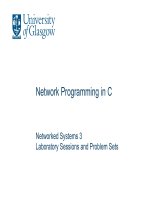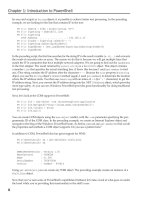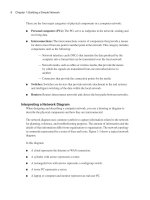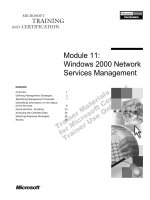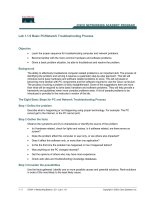Twisted Network Programming Essentials pptx
Bạn đang xem bản rút gọn của tài liệu. Xem và tải ngay bản đầy đủ của tài liệu tại đây (10.02 MB, 193 trang )
www.it-ebooks.info
www.it-ebooks.info
Jessica McKellar and Abe Fettig
SECOND EDITION
Twisted Network Programming
Essentials
www.it-ebooks.info
Twisted Network Programming Essentials, Second Edition
by Jessica McKellar and Abe Fettig
Copyright © 2013 Jessica McKellar. All rights reserved.
Printed in the United States of America.
Published by O’Reilly Media, Inc., 1005 Gravenstein Highway North, Sebastopol, CA 95472.
O’Reilly books may be purchased for educational, business, or sales promotional use. Online editions are
also available for most titles (). For more information, contact our corporate/
institutional sales department: 800-998-9938 or
Editor: Meghan Blanchette
Production Editor: Christopher Hearse
Copyeditor: Rachel Head
Proofreader: Amanda Kersey
Indexer: Bob Pfahler
Cover Designer: Randy Comer
Interior Designer: David Futato
Illustrator: Rebecca Demarest
March 2013:
Second Edition
Revision History for the Second Edition:
2013-03-11: First release
See for release details.
Nutshell Handbook, the Nutshell Handbook logo, and the O’Reilly logo are registered trademarks of O’Reilly
Media, Inc. Twisted Network Programming Essentials, 2nd Edition, an image of a ball of snakes, and related
trade dress are trademarks of O’Reilly Media, Inc.
Many of the designations used by manufacturers and sellers to distinguish their products are claimed as
trademarks. Where those designations appear in this book, and O’Reilly Media, Inc., was aware of a trade‐
mark claim, the designations have been printed in caps or initial caps.
While every precaution has been taken in the preparation of this book, the publisher and authors assume
no responsibility for errors or omissions, or for damages resulting from the use of the information contained
herein.
ISBN: 978-1-449-32611-1
[LSI]
www.it-ebooks.info
Table of Contents
Foreword to the First Edition. . . . . . . . . . . . . . . . . . . . . . . . . . . . . . . . . . . . . . . . . . . . . . . . . . . . . ix
Preface. . . . . . . . . . . . . . . . . . . . . . . . . . . . . . . . . . . . . . . . . . . . . . . . . . . . . . . . . . . . . . . . . . . . . . xiii
Part I. An Introduction to Twisted
1.
Getting Started. . . . . . . . . . . . . . . . . . . . . . . . . . . . . . . . . . . . . . . . . . . . . . . . . . . . . . . . . . . . . 3
Installing Twisted 3
Installation on Linux 3
Installation on Windows 4
Installation on OS X 5
Installing from Source 5
Required Dependencies 5
Installing Twisted from a Release Tarball 6
Installing Twisted from a Source Checkout 6
Installing Optional Dependencies from Source 6
Testing Your Installation 7
Using the Twisted Documentation 8
API Documentation 8
Subproject Documentation 8
Finding Answers to Your Questions 8
Mailing Lists 9
IRC Channels 9
Stack Overflow 9
Twisted Blogs 9
2.
Building Basic Clients and Servers. . . . . . . . . . . . . . . . . . . . . . . . . . . . . . . . . . . . . . . . . . . . . 11
A TCP Echo Server and Client 11
Event-Driven Programming 12
The Reactor 14
iii
www.it-ebooks.info
Transports 14
Protocols 15
Protocol Factories 16
Decoupling Transports and Protocols 16
A TCP Quote Server and Client 16
Protocol State Machines 19
More Practice and Next Steps 22
3.
Writing Asynchronous Code with Deferreds. . . . . . . . . . . . . . . . . . . . . . . . . . . . . . . . . . . . . 25
What Deferreds Do and Don’t Do 25
The Structure of a Deferred Object 26
Callback Chains and Using Deferreds in the Reactor 28
Practice: What Do These Deferred Chains Do? 30
Exercise 1 31
Exercise 2 31
Exercise 3 31
Exercise 4 32
Exercise 5 32
Exercise 6 33
The Truth About addCallbacks 33
Exercise 7 34
Exercise 8 35
Key Facts About Deferreds 35
Summary of the Deferred API 36
More Practice and Next Steps 36
4.
Web Servers. . . . . . . . . . . . . . . . . . . . . . . . . . . . . . . . . . . . . . . . . . . . . . . . . . . . . . . . . . . . . . . 39
Responding to HTTP Requests: A Low-Level Review 39
The Structure of an HTTP Request 40
Parsing HTTP Requests 42
Handling GET Requests 43
Serving Static Content 43
Serving Dynamic Content 45
Dynamic Dispatch 46
Handling POST Requests 48
A Minimal POST Example 48
Asynchronous Responses 49
More Practice and Next Steps 51
5.
Web Clients. . . . . . . . . . . . . . . . . . . . . . . . . . . . . . . . . . . . . . . . . . . . . . . . . . . . . . . . . . . . . . . . 53
Basic HTTP Resource Retrieval 53
Printing a Web Resource 53
iv | Table of Contents
www.it-ebooks.info
Downloading a Web Resource 54
Agent 55
Requesting Resources with Agent 55
Retrieving Response Metadata 57
POSTing Data with Agent 58
More Practice and Next Steps 60
Part II. Building Production-Grade Twisted Services
6.
Deploying Twisted Applications. . . . . . . . . . . . . . . . . . . . . . . . . . . . . . . . . . . . . . . . . . . . . . 63
The Twisted Application Infrastructure 63
Services 64
Applications 64
TAC Files 64
twistd 65
Plugins 66
More twistd Examples 68
More Practice and Next Steps 68
Suggested Exercises 69
7.
Logging. . . . . . . . . . . . . . . . . . . . . . . . . . . . . . . . . . . . . . . . . . . . . . . . . . . . . . . . . . . . . . . . . . . 71
Basic In-Application Logging 71
twistd Logging 73
Custom Loggers 73
Key Facts and Caveats About Logging 75
8.
Databases. . . . . . . . . . . . . . . . . . . . . . . . . . . . . . . . . . . . . . . . . . . . . . . . . . . . . . . . . . . . . . . . . 77
Nonblocking Database Queries 77
More Practice and Next Steps 80
9.
Authentication. . . . . . . . . . . . . . . . . . . . . . . . . . . . . . . . . . . . . . . . . . . . . . . . . . . . . . . . . . . . . 81
The Components of Twisted Cred 81
Twisted Cred: An Example 82
Credentials Checkers 86
Authentication in Twisted Applications 89
More Practice and Next Steps 91
10.
Threads and Subprocesses. . . . . . . . . . . . . . . . . . . . . . . . . . . . . . . . . . . . . . . . . . . . . . . . . . . 93
Threads 93
Subprocesses 96
Running a Subprocess and Getting the Result 96
Table of Contents | v
www.it-ebooks.info
Custom Process Protocols 97
More Practice and Next Steps 100
11. Testing. . . . . . . . . . . . . . . . . . . . . . . . . . . . . . . . . . . . . . . . . . . . . . . . . . . . . . . . . . . . . . . . . . 103
Writing and Running Twisted Unit Tests with Trial 103
Testing Protocols 104
Tests and the Reactor 108
Testing Deferreds 109
Testing the Passage of Time 112
More Practice and Next Steps 115
Part III. More Protocols and More Practice
12.
Twisted Words. . . . . . . . . . . . . . . . . . . . . . . . . . . . . . . . . . . . . . . . . . . . . . . . . . . . . . . . . . . . 119
IRC Clients 119
IRC Servers 121
More Practice and Next Steps 124
13.
Twisted Mail. . . . . . . . . . . . . . . . . . . . . . . . . . . . . . . . . . . . . . . . . . . . . . . . . . . . . . . . . . . . . . 125
SMTP Clients and Servers 126
The SMTP Protocol 126
Sending Emails Using SMTP 127
SMTP Servers 128
Storing Mail 130
IMAP Clients and Servers 132
IMAP Servers 133
IMAP Clients 137
POP3 Clients and Servers 139
POP3 Servers 139
More Practice and Next Steps 143
14.
SSH. . . . . . . . . . . . . . . . . . . . . . . . . . . . . . . . . . . . . . . . . . . . . . . . . . . . . . . . . . . . . . . . . . . . . 145
SSH Servers 145
A Basic SSH Server 145
Using Public Keys for Authentication 151
Providing an Administrative Python Shell 153
Running Commands on a Remote Server 156
SSH Clients 156
More Practice and Next Steps 159
15. The End. . . . . . . . . . . . . . . . . . . . . . . . . . . . . . . . . . . . . . . . . . . . . . . . . . . . . . . . . . . . . . . . . . 161
vi | Table of Contents
www.it-ebooks.info
Contributing to Twisted 161
Index. . . . . . . . . . . . . . . . . . . . . . . . . . . . . . . . . . . . . . . . . . . . . . . . . . . . . . . . . . . . . . . . . . . . . . . 163
Table of Contents | vii
www.it-ebooks.info
www.it-ebooks.info
Foreword to the First Edition
“
My name is Ozymandius, king of kings:
Look on my words, ye Mighty, and despair!”
Nothing beside remains. Round the decay
Of that colossal wreck, boundless and bare
The lone and level sands stretch far away.
—Percy Bysshe Shelly, “Ozymandius”
As the Twisted project’s originator and nominal leader—and as someone who is not
being paid for writing this—I can very honestly say that this is a fine book, and it has
made me proud of what I’ve started. You now hold in your hands a wondrous key that
contains the knowledge to unlock a very powerful software system—a software system
borne of a consistent, methodical vision; a vision half a decade in realization and hun‐
dreds of man-years in implementation; a vision for a video game that has yet to be
written, called “Divunal.”
I have been lauded many times for my role in Twisted’s creation, and in this foreword I
will attempt to disabuse you of the notion that any of it was on purpose. Not only was
it an accident, but neither I, nor anyone else, has made one iota of progress towards my
original goal of writing a game.
When I was eight years old, I decided I wanted to be a writer. I was going to write video
games just like my favorite ones, the text-based games from Infocom. They were like
books, but better. I knew how to write already—at a fourth-grade level, or so I’m
told—and all I needed to figure out was the part where the computer wrote back. Lucky
for you nobody thought to tell me how hard that step between the input and the output
was, or Twisted would be a series of detective novels instead of a Python program.
Tolkien said it best: “The tale grew in the telling,” and I’ll say it worse: the code grew in
the hacking. Twisted began over a decade after my aforementioned first plunge into the
netherworld of software, as a solitary attempt to create a networking subsystem for a
small online fantasy world. Since then, it has become an ongoing community quest to
ix
www.it-ebooks.info
1. And difficult! Making an online game work properly is hard.
2. And intelligent! People who solve unusual problems are always learning.
3. Caution for the humorless: this is a joke. I am not actually an enemy of freedom. Still, there is some truth to this.
unify all manner of asynchronous communications. This book will take you on an
adventure through Twisted for the Web, Twisted for email, Twisted for chat, and of
course, Twisted for whatever new kind of networked application you want to dream
up—maybe even an online video game.
Much as the tale of Twisted has grown and changed, its origins still have a profound
effect on its nature, and on its future. Having origins in an eclectic
1
problem domain
has attracted an eclectic
2
audience. The community in the online support forum engages
in discussions that are “often funny.” To put it more directly: we’re weird.
“Weird” is a badge I have long worn with pride, dear reader, so please take it as a com‐
pliment that I bestow it upon you. You’re not simply non-average, you’re better than
average. Almost by definition, Twisted hackers are the ones for whom “good enough”
isn’t good enough. You are the web programmers who can’t use their operating system’s
stock HTTP daemon because you need more power and more control over how it’s run;
the chat developers who aren’t content with chatting on a perfectly working network
just because it doesn’t support some cool new features you want; the (dare I say it?)
gamers who aren’t content with the market’s offerings of online games. You want to
create something newer, different, better. To build higher than those who have come
before, because you are building not merely upon the shoulders of giants, but upon the
apex of an acrobatic balancing act of giants, or more literally an interlocking network
of frameworks and libraries for different tasks, rather than just one at a time.
Twisted will let you do that, by letting you leverage code written by far more and far
better programmers than I. Twisted provides a common method for that code to co‐
operate, which means you can use all of that code without performing a complex inte‐
gration pass. In this spirit, I’d like to invite you to release your Twisted-based projects,
or the infrastructure components of them, as open source software, so that we might
together build a Twisted commons upon which many more fantastic applications will
be built.
Don’t mistake this friendly vision for altruism, however. I didn’t have anything to do
with the start of the Free Software or Open Source movements, respectively, but they
came along at a convenient time for me. This feeling of share-and-share-alike has been
a feature of the Twisted community since day one, but not because I care about sharing.
3
It is because—I may have mentioned this—I want to write a video game one day. A game
that effortlessly connects to the Web and to your email, that politely requests that you
play when you have time, and that reminds you to get back to work when you do not.
x | Foreword to the First Edition
www.it-ebooks.info
You see, the majority of Twisted’s core developers, including myself, suffer from Atten‐
tion Deficit Disorder. This malady is the grease that makes the magic wheels of inte‐
gration turn. While most developers—sane developers—would be content to write a
perfectly good web server that could work only as a web server and leave it at that, we
are always afraid we’ll suddenly lose interest and need a chat application instead—or
maybe it should be a mail server? Hey, there’s a squirrel! I don’t like this song.
What was I saying? Oh yes. The essence of Twisted is apparently paradoxical. Created
on a whim by crazed eccentrics, designed to be a toy, and yet powerful enough to drive
massive email systems, high-traffic web sites, transaction-processing systems, and in‐
ventory management applications.
However, the paradox is an illusion. People produce the best work when they are work‐
ing and having fun at the same time. It takes a sense of humor to call yourself a crazed
eccentric (whether it’s true or not). You have to have a sense of fun to try and build a
toy. In enjoying ourselves, we have brought to life a system that many of us have tried
and been unable to create in more serious surroundings.
So, when I look out upon the “lone and level sands” of Divunal, a game whose incar‐
nation today is little more than its name, I am not concerned. I am having a good time
with Twisted. With this book in hand, I have no doubt that you will, too.
—Matthew “the Glyph” Lefkowitz
CTO at Divmod, Inc.
(not a game company)
(yet)
August 2005
Foreword to the First Edition | xi
www.it-ebooks.info
www.it-ebooks.info
Preface
This book is about Twisted, an open source, event-driven networking engine written in
Python.
Twisted supports many common transport and application layer protocols, including
TCP, UDP, SSL/TLS, HTTP, IMAP, SSH, IRC, and FTP. Like the language in which it is
written, it is “batteries-included”; Twisted comes with client and server implementations
for all of its protocols, as well as utilities that make it easy to configure and deploy
production-grade Twisted applications from the command line.
Twisted includes both high- and low-level tools for building performant, cross-platform
applications. You can deploy a web or mail server with just a few lines of code, or you
can write your own protocol from scratch. At every level, Twisted provides a tested,
RFC-conforming, extensible API that makes it possible to rapidly develop powerful
network software.
In keeping with the spirit of the O’Reilly Essentials series, this book is not about torturing
you with the nitty-gritty details of specific networking protocols, or with exhaustively
documenting Twisted’s APIs. For a comprehensive treatment of how to use Twisted to
build applications for a particular protocol, please get your footing with this book and
then consult the official documentation.
Instead, the goal of this book is to give you fluency in the primitives Twisted provides
and the idioms that it uses to build network clients and servers. It starts with an intro‐
duction to the underlying event-driven model and a big-picture view of Twisted as a
framework, focusing on simple, self-contained examples that you can play with and
extend as you explore Twisted’s APIs. Where possible, the client and server examples
are written so they can be run together.
After reading this book, you will have the tools and conceptual background to build any
event-driven client or server application you need, not just for the protocols that are a
part of Twisted and covered in this book, but also for new protocols that you build using
Twisted’s primitives.
xiii
www.it-ebooks.info
Why Use Twisted?
Why should you use Twisted instead of some other networking library or framework?
Here are a few compelling reasons. Twisted is:
Python-powered
Twisted is written in Python, a powerful, object-oriented, interpreted language.
Python is a language that inspires great enthusiasm among its fans, and for good
reason. It’s a joy to program in Python, which is easy to write, easy to read, and easy
to run. And because Python is cross-platform, you can run the same Twisted ap‐
plication on Linux, Windows, Unix, and Mac OS X.
Asynchronous and event-based
Synchronous network libraries leave developers with a painful choice: either allow
the application to become unresponsive during network operations, or introduce
the additional complexity of threading. Twisted’s event-based, asynchronous
framework makes it possible to write applications that stay responsive while pro‐
cessing events from multiple network connections, without using threads.
Full-featured
Twisted includes an amazing amount of functionality. Mail, web, news, chat, DNS,
SSH, Telnet, RPC, database access, and more—it’s all there, ready for you to use.
Flexible and extensible
Twisted provides high-level classes to let you get started quickly. But you’ll never
find yourself limited by the way things work out of the box. If you need advanced
functionality, or if you need to customize the way a protocol works, you can. You
can also write your own protocol implementation, to control every byte sent over
the wire.
Open source
Twisted is free, both as in beer and as in freedom. It includes full source code and
is released under a liberal license. Want to distribute all or part of Twisted with your
application? You’re welcome to do so, with no obligations to release your own code
or pay any licensing fees. Want to get a better understanding of how an object in
Twisted works? Take a look at the source. And when you get to the point where
you’re developing your own improvements and extensions to Twisted, you can
contribute them to the community for the benefit of others.
Community-backed
Twisted has an active community of developers and users. If you run into a problem,
you’ll find many fellow developers ready to help on one of the Twisted mailing lists
(see “Finding Answers to Your Questions” on page 8, in Chapter 1). Or you can
drop into the #twisted IRC channel, where the chances are good you’ll be able to
start a live conversation with the very person who wrote the code you’re having
trouble with.
xiv | Preface
www.it-ebooks.info
An integration-friendly platform
A Twisted application can share data between several different services within the
same process. This makes integration tasks a snap. You can write an SMTP-to-
XMLRPC proxy, an SSH server that lets you update a website, or a web discussion
board that includes an NNTP interface. If you need to transfer data between systems
that don’t speak the same protocol, Twisted will make your job a whole lot easier.
What This Book Covers
This book does not attempt to exhaustively document every module and class available
for the Twisted framework. Instead, it focuses on presenting practical examples of the
most common tasks that developers building network applications face. This book will
also help you to understand the key concepts and design patterns used in Twisted
applications.
This book has three parts:
Learning Twisted basics through building basic clients and servers
This part covers installing Twisted, an architectural overview of the framework,
and building basic TCP clients and servers. We then apply the primitives and idioms
from the chapters on basic applications to a variety of client and server examples
for a particular protocol, HTTP.
Building production-grade servers
At this point, well-practiced with basic clients and servers, we focus on deploying
these applications in a robust and standardized fashion using the Twisted applica‐
tion infrastructure. This part also adds to our repertoire common components of
production-grade servers: logging, database access, authentication, using threads
and processes in a Twisted-safe way, and testing.
More practice through examples from other protocols
For more practice, to give a sense of Twisted’s breadth, and to cover many popular
uses of Twisted, the final part of the book explores clients and servers for IRC,
various mail protocols, and SSH.
Conventions Used in This Book
This book uses standard typographical conventions to highlight different types of text.
You’ll see the following font styles used:
Italic
Used for emphasis, to highlight technical terms the first time they appear, and for
commands, packages, filenames, directories, and URLs
Preface | xv
www.it-ebooks.info
Constant width
Used for code samples, and for the names of variables, classes, objects, and functions
when they are used within the main text of the book
Constant width bold
Shows user input at the command line and interactive prompts
Constant width bold italic
Shows placeholder user input that you should replace with something that makes
sense for you
This icon signifies a tip, suggestion, or general note.
This icon indicates a warning or caution.
What You’ll Need
This book assumes a familiarity with programming in Python. If you’re looking for a
good introduction to Python, check out Learning Python, by Mark Lutz (O’Reilly), or
Dive Into Python, by Mark Pilgrim (Apress). You should have a Linux, Mac OS X, or
Windows computer with Python version 2.6 or 2.7 installed. Python 2.6 is included in
Mac OS X 10.6 (“Snow Leopard”) and higher and in many Linux distributions. If you
don’t already have Python installed, you can download it for free from the Python home
page.
Changes Since the Previous Edition
The first edition of Twisted Networking Essentials was released in 2005. Since then,
networking protocols have come in and out of fashion, and Twisted’s APIs have evolved
and matured. This second edition builds upon the excellent foundation first edition
author Abe Fettig crafted by trimming off aged protocols and Twisted APIs and covering
more Twisted subprojects and features.
In particular, this edition removes the chapter on NNTP and adds chapters on building
IRC clients and servers and testing your Twisted applications using the Trial framework.
The sections on deploying production-grade services using the Twisted application in‐
frastructure have been significantly expanded. In addition to a discussion and examples
of Twisted applications and Twisted plugins, logging, working with databases, and using
threads and processes all now get more coverage in their own chapters.
xvi | Preface
www.it-ebooks.info
The focus of this book has also been sharpened to give you fluency in Twisted’s primitives
and idioms with minimal distraction from the nitty-gritty details of specific protocols.
Almost all of the examples have been streamlined, and where reasonable, reworked so
that you have client and server pairs that can be run together to maximize experimen‐
tation value. Also, as part of building a solid conceptual foundation, the section on
Deferreds, a frequent source of confusion and frustration for developers new to event-
driven programming, has been expanded into its own chapter with many more
examples.
Since the structure and many of the examples have changed, it is hard to give a short
and complete enumeration of the differences between this edition and the last. I hope
this has given you some idea, though, and I welcome your thoughts and feedback.
Portions of Chapters 2, 3, and 6 were adapted from the author’s chapter on Twisted for
The Architecture of Open Source Applications, Volume II under a Creative Commons
Attribution 3.0 Unported license. You can find out more about this book at The Archi‐
tecture of Open Source Applications home page and about this license at the Creative
Commons website.
Using Code Examples
This book is here to help you get your job done. In general, if this book includes code
examples, you may use the code in your programs and documentation. You do not need
to contact us for permission unless you’re reproducing a significant portion of the code.
For example, writing a program that uses several chunks of code from this book does
not require permission. Selling or distributing a CD-ROM of examples from O’Reilly
books does require permission. Answering a question by citing this book and quoting
example code does not require permission. Incorporating a significant amount of ex‐
ample code from this book into your product’s documentation does require permission.
We appreciate, but do not require, attribution. An attribution usually includes the title,
author, publisher, and ISBN. For example: “Twisted Network Programming Essentials,
Second Edition, by Jessica McKellar and Abe Fettig (O’Reilly). Copyright 2013 Jessica
McKellar, 978-1-4493-2611-1.”
If you feel your use of code examples falls outside fair use or the permission given above,
feel free to contact us at
Safari® Books Online
Safari Books Online (
www.safaribooksonline.com) is an on-demand
digital library that delivers expert content in both book and video
form from the world’s leading authors in technology and business.
Preface | xvii
www.it-ebooks.info
Technology professionals, software developers, web designers, and business and crea‐
tive professionals use Safari Books Online as their primary resource for research, prob‐
lem solving, learning, and certification training.
Safari Books Online offers a range of product mixes and pricing programs for organi‐
zations, government agencies, and individuals. Subscribers have access to thousands of
books, training videos, and prepublication manuscripts in one fully searchable database
from publishers like O’Reilly Media, Prentice Hall Professional, Addison-Wesley Pro‐
fessional, Microsoft Press, Sams, Que, Peachpit Press, Focal Press, Cisco Press, John
Wiley & Sons, Syngress, Morgan Kaufmann, IBM Redbooks, Packt, Adobe Press, FT
Press, Apress, Manning, New Riders, McGraw-Hill, Jones & Bartlett, Course Technol‐
ogy, and dozens more. For more information about Safari Books Online, please visit us
online.
How to Contact Us
Please address comments and questions concerning this book to the publisher:
O’Reilly Media, Inc.
1005 Gravenstein Highway North
Sebastopol, CA 95472
800-998-9938 (in the United States or Canada)
707-829-0515 (international or local)
707-829-0104 (fax)
We have a web page for this book, where we list errata, examples, and any additional
information. You can access this page at />To comment or ask technical questions about this book, send email to bookques
For more information about our books, courses, conferences, and news, see our website
at .
Find us on Facebook: />Follow us on Twitter: />Watch us on YouTube: />Acknowledgments
Twisted was my first-ever experience with open source contribution. I am so grateful
that as a naive and clueless intern way back when, Glyph, JP, Itamar, and others patiently
guided me through the contribution process and invested their time in making me a
core developer for the project. What I’ve learned from this wonderful community
xviii | Preface
www.it-ebooks.info
continues to influence my open source and software engineering sensibilities and dis‐
cipline today, and I strive to give back half as much as they’ve given me.
Thank you Christopher Armstrong, Andrew Bennetts, Jean-Paul Calderone, Thomas
Herve, Kevin Horn, Laurens Van Houtven, James Knight, Jonathan Lange, Glyph Lef‐
kowitz, Ying Li, Duncan McGreggor, Ashwini Oruganti, David Reid, Allen Short, David
Sturgis, Kevin Turner, and the many other contributors who have helped me and who
steward Twisted, support new contributors, help users, write code, write documenta‐
tion, write tests, and maintain the infrastructure for Twisted. It is truly a group effort.
Thank you Adam Fletcher and Laurens Van Houtven for providing technical reviews
for this edition. I appreciate your tolerance for my propensity for deadline-driven de‐
velopment. Your feedback has made this book much stronger. Thank you to my editor
Meghan Blanchette, whose stuck with and pushed me patiently as at each deadline I
tried to creep in one last tweak I promise.
Preface | xix
www.it-ebooks.info
www.it-ebooks.info
PART I
An Introduction to Twisted
www.it-ebooks.info
www.it-ebooks.info
CHAPTER 1
Getting Started
Before you can start developing applications using Twisted, you’ll need to download
and install Twisted and its dependencies. This chapter walks you through the installation
process on various operating systems. It also shows you how to add the Twisted utilities
to your path, familiarize yourself with the Twisted documentation, and get answers to
your questions from the Twisted community.
These instructions assume that you are familiar with Python and, in the case of source
installations, comfortable navigating and installing packages from the command line.
Twisted requires Python 2.6 or 2.7. Support for Python 3.0 is in progress at the time of
this writing.
Installing Twisted
First things first: you need to get Twisted installed on your computer. Downloads and
instructions for installing Twisted on various operating systems can be found on the
Twisted home page, with additional instructions and links to older releases at this
Twisted page. To enable additional functionality in Twisted, you’ll have to install a cou‐
ple of optional packages as well.
You can find everything you need on the Twisted website, but if you’d like you can also
browse this page on PyPI for the source, Windows installers, and download statistics.
Installation on Linux
All of the popular Linux distributions maintain a python-twisted package as well as
packaged versions of Twisted’s dependencies. To install Twisted on a dpkg-based system,
run:
apt-get install python-twisted
3
www.it-ebooks.info
